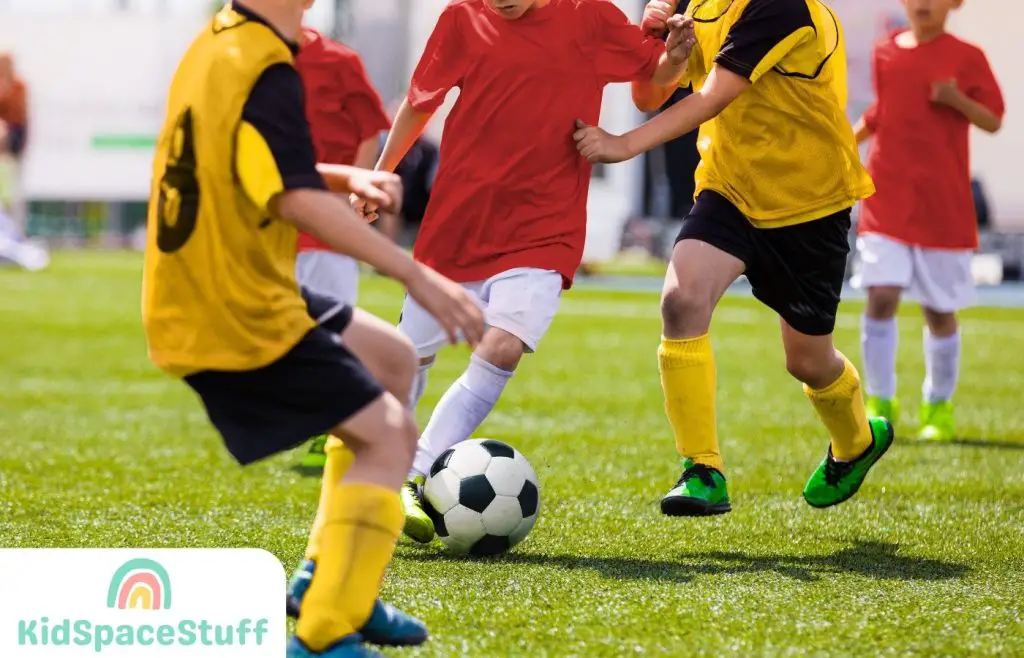Ever wondered how long your little footballer will be out on the field during a soccer game?
The duration can vary based on age, league rules, and tournament specifics.
In this article, I’m going to break down the typical length of children’s soccer games, the reasons behind these time frames, and what this means for you as a supportive parent on the sidelines. So, grab your favorite seat, warm up those cheering voices, and let’s delve into the exciting, fast-paced world of kids’ soccer!
Kids Soccer Game Length

You might be wondering how long a kids soccer game lasts. Well, I’ve got you covered! The length of a youth soccer game depends on the age group of the children playing. Here’s a handy breakdown for you:
- Under-6 (U6) and Under-8 (U8): These age groups typically play four 8-10 minute quarters, with a total game length of around 32-40 minutes. There’s usually a 5-minute break between quarters, making the entire event about 45 minutes to an hour.
- Under-10 (U10) and Under-12 (U12): In these age groups, matches consist of two 25-30 minute halves, totaling 50-60 minutes of play. A halftime break of around 10 minutes separates the halves, resulting in an overall event time of approximately 1-1.5 hours.
- Under-14 (U14) to Under-19 (U19): As the children get older, soccer games become longer. In these age groups, matches are typically composed of two 35-45 minute halves, totaling 70-90 minutes of play. These games also have a 10-15 minute halftime break, putting the total event time around 1.5-2 hours.
Of course, these are just general guidelines – individual leagues and clubs might have their own specific rules determining the length of a youth soccer game. It’s always a good idea to check with your local organization for specific game durations.
In youth soccer, shorter game lengths help keep kids engaged, as younger children might not have the endurance to play longer matches. It also allows for better skill development, since coaches can use the breaks to provide valuable feedback to improve their players’ performances on the field. So next time you’re planning your weekend around a children’s soccer game, you’ll know just about how much time to set aside.
How Long is a Kids Soccer Game by Age Group Division
U8 and U10
At the U8 and U10 level, kids soccer games are generally shorter in order to accommodate the younger players’ attention spans and energy levels. We usually see games consisting of two halves, each lasting about 20-25 minutes, with a 5-10 minute break in between. Sometimes you might find variations in this structure, but the overall target is maintaining manageable game lengths for the kids.
U12 and U14
As the kids mature and reach U12 and U14 age groups, game durations increase to reflect their improved physical abilities and understanding of the game. Typically, matches at these age divisions consist of two 30-minute halves, separated by a 10-minute halftime break. This extended time gives players the opportunity to showcase their skills, teamwork, and strategies, while still maintaining a reasonable duration.
U16 and U19
For players in the U16 and U19 age groups, the lengths of their soccer matches are usually comparable to adult games. These matches often feature two 40-45 minute halves, with a 10-15 minute halftime break. The increased time allows for a more competitive and intense environment, as these players are getting closer to the adult level in terms of skill and physicality. This duration is generally considered appropriate for the teenage athletes in these age groups.
In conclusion, the length of kids soccer games varies depending on the age group divisions, gradually increasing as the players mature and develop their skills. This ensures an appropriate balance between challenge, competitiveness, and enjoyment for all participants involved.
Game Structure
Halves vs Quarters
In kids soccer games, the match is typically divided into either halves or quarters. The decision to use halves or quarters usually depends on the age group and league rules. Generally, younger age groups play shorter games with more breaks, which means they’ll have quarters. As kids get older, we transition to halves for a more continuous and longer game.
Halftime Break
Regardless of whether the game is split into halves or quarters, there’s always a halftime break. This break gives the young players a chance to rest, rehydrate, and get new instructions from their coaches. Halftime breaks usually last for about 5 to 10 minutes, depending on the age group and league.
Stoppage Time
Stoppage time refers to the additional time added to the end of each half to make up for any lost time due to injuries, substitutions, or other game delays. In adult soccer games, stoppage time is common, but we typically don’t see much stoppage time added in kids soccer games. Referees usually prioritize player safety and keep the game moving at a brisk pace.
Overtime and Penalty Shootout
Overtime and penalty shootouts are used to determine a winner in case of a tie during knockout stages, like a tournament or playoff. In kids soccer, overtime might involve two shorter extra time periods, often without the golden goal or sudden death rule. If the scores are still level after extra time, we move on to penalty shootouts. Each team takes turns attempting a set number of penalty kicks, and the team with the most successful kicks wins the match. It’s an intense, thrilling way to end a close game.
By keeping these game structure elements in mind, we can ensure that kids soccer matches are enjoyable, competitive, and fair for all players involved.
Comparing Game Lengths

When we talk about soccer game lengths, it’s essential to know that they can vary depending on the age groups and league levels. Let’s compare the lengths of kids’ soccer games to professional and college soccer games.
In kids’ soccer games, the duration typically depends on their age group. For example, matches for younger children (under 8 years) can have 20-minute halves to make it more suitable and enjoyable for them. As they grow older and gain more experience, game lengths increase to resemble more competitive leagues such as high school and college soccer.
A professional soccer game usually lasts 90 minutes, consisting of two 45-minute halves. There’s also a 15-minute halftime break in between. Stoppage time, added by the referee for any delays or injuries during the match, can make these games slightly longer than 90 minutes.
College soccer games share similarities with professional matches in terms of length. Both men’s and women’s college soccer games have two 45-minute halves, with a 15-minute halftime break. However, unlike professional soccer, college games may have a few additional rules, like each team being allowed a limited number of substitutions.
To sum up, kids’ soccer games have shorter durations tailored to their age group and abilities, while professional and college games last for 90 minutes, plus extra stoppage time, providing a more competitive and demanding environment. Incorporating casual tone, the section described the game lengths, differences in rules, and how they adapt to various age groups and leagues.
Frequently Asked Questions
What’s the duration of a soccer game for 8-year-olds?
For 8-year-olds, soccer games typically last around 40-50 minutes, with each half lasting 20-25 minutes. There is usually a short break between the halves, giving the kids some time to catch their breath and get ready for the next half of the game.
How long do soccer games last for different age groups?
Soccer games vary in length depending on the age group. Generally speaking, the older the players are, the longer the match will be. Here’s a rough breakdown by age group:
- U6 (Under 6 years old): 16-20 minute games (4-5 minute quarters)
- U8 (Under 8 years old): 40-50 minute games (20-25 minute halves)
- U10 (Under 10 years old): 50-60 minute games (25-30 minute halves)
- U12 (Under 12 years old): 60-70 minute games (30-35 minute halves)
- U14 (Under 14 years old): 70-80 minute games (35-40 minute halves)
Keep in mind that these durations can vary slightly depending on the league and local regulations.
What’s the length of a soccer game for 13-year-olds?
For 13-year-olds, who typically fall into the U14 (Under 14 years old) category, soccer games generally last about 70-80 minutes. The game is split into two halves, each lasting 35-40 minutes, with a short break in between for players to rest and strategize with their coaches.
How long do U9 and U10 soccer games typically last?
U9 (Under 9 years old) and U10 (Under 10 years old) soccer games usually last between 50-60 minutes. Each half of the game will be around 25-30 minutes long, with a brief intermission in the middle for players to rest and recover.
Final Thoughts
The length of a kids’ soccer game varies widely based on the age group and specific league rules.
For the youngest players, under the age of 6, games typically consist of four 8-minute quarters with a 5-10 minute break at halftime. As kids get older, the game lengths increase. For ages 6 to 12, it’s common to have two 25-minute halves with a 5-10 minute halftime break. When children reach the age of 13 and up, games typically mirror adult games with two 45-minute halves and a 10-15 minute halftime break. However, these times can change slightly depending on the league and the tournament rules.
Remember to always check with your child’s coach or league official to confirm the exact timing of the games but they’re pretty similar to a kids baseball game. Enjoy cheering on your little soccer star and don’t forget to pick up one of these kids soccer balls!
KidSpaceStuff is a site dedicated to helping parents find the best interior design, activities, and inspiration for their kids.